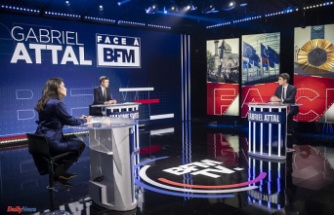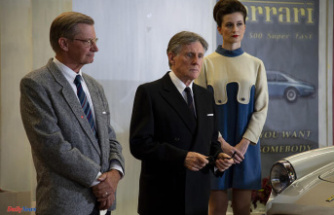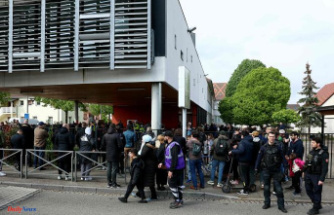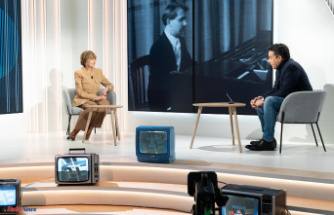‘Firelei Báez: Bloodlines'
When: Through May 21; 10 a.m.-5 p.m. Tuesdays-Sundays; until 10 p.m. Fridays
Where: Andy Warhol Museum, 117 Sandusky St., North Side, Pittsburgh
Admission: $20; $10 for senior citizens, children and students; half-price admission with Good Fridays program, Fridays 5-10 p.m.
Details: 412-237-8300 or warhol.org
Sign up for one of our email newsletters.
Updated 20 hours ago
Tracing the history of black resistance movements in the Unites States and the Caribbean, Firelei Báez's solo exhibit “Bloodlines,” currently on display at the Andy Warhol Museum, presents a series of new large-scale works filled with symbols of power and “reclaimed histories,” says Jessica Beck, the Warhol's associate curator of art.
“A lot of this show is about that, about reclaiming a power or reclaiming history,” Beck says. “Taking a historical narrative that has a lot of gaps in it and talking about those gaps.”
The first museum solo show by the Brooklyn-based Báez, it was originally on display last year at the Pérez Art Museum in Miami. That show contained a dozen large-scale works organized by the Miami museum's assistant curator, María Elena Ortiz.
Here, Beck has added another half-dozen works, which not only serve to further flesh out the artist's concepts and influences, but also expand on the original exhibit physically. Most notably, architectural passageways were added linking one work to the next, and especially pitting one painting — “Sans-Souci (this threshold between a dematerialized and a historicized body)” — opposite another, “Bloodlines (past forces of oppression become frail and fallible).”
The former features a large ruby red silhouette of a woman, her hair bound in a headscarf. This headscarf references a tignon, a kind of headwrap that black women were forced by law to wear in 18th-century Louisiana to make them less attractive to white men.
“As an act of defiance, the women quickly began decorating their headdresses with beautiful textiles, ribbons and feathers, transforming a tool of oppression into one of power,” Beck says. “In this painting, Báez acknowledges the history of the garment and reinterprets it as a symbol of pride and resistance.”
Opposite hangs the show's namesake piece, “Bloodlines (past forces of oppression become frail and fallible).”
In this painting, Báez created her own headscarf, filled with an intricate indigo pattern painted with historical and contemporary symbols, such as a panther, in reference to the American black power movement of the 1960s, and azabache, a black or red coral charm in the form of a fist, worn in certain Latin American cultures to protect against the Mal de ojo, or evil eye.
Beck says Báez's choice of indigo also points to a symbolic history of power.
“The potent blue-violet dye originated in India and became extremely prized throughout the African slave trade,” she says. “At the peak of its value in the early 1700s, a length of indigo fabric functioned like currency and could be traded for a human slave.”
Here Báez contrasts dehumanizing economic, racial and political systems with symbols of empowerment and resistance.
Another standout work is “Can I pass? Introducing the paper bag to the fan test for the month of June.”
Configured as a calendar grid, “Can I Pass?” consists of 30 self-portraits documenting daily changes to the artist's appearance during the month of June in 2011.
The silhouettes are painted in shades of light brown that match the artist's skin tone. They are expressionless except for their eyes, which stare directly and defiantly at the viewer.
“Her skin tone changes, as she got more tan throughout the month,” Beck says.
Here Báez references two tests that were historically used to qualify and categorize blackness. The “brown paper bag test” (in which a person's complexion was compared to the hue of a brown paper bag) was used as a social ranking system well into the 20th century.
Dark-skinned African Americans were excluded from churches, social clubs and fraternities while privilege was given to light-skinned individuals.
The paintings also reflect the movement of the artist's hair, as the source photographs were taken while she was standing near a fan.
“In the Dominican Republic, the ‘fan test' classified blackness on the basis of whether hair flowed naturally or remained stiff when placed in front of a fan,” Beck says. “These forms of racial bias and stereotype continue to permeate standards of beauty today. In this work, Báez places her own hair and skin against these tests.”
Finally, several paintings featuring a hirsute woman are based on the ciguapa, a mythological creature from Dominican folklore.
Traditionally depicted as a sensuous nude, the ciguapa is known for preying on men to bring either darkness or light into their lives, similar to the Western mermaid or siren who would steer sailors off course. “The ciguapa is a trickster character,” says Beck. “She is said to have backward-facing feet, making it impossible to trace her steps.”
Challenging conventions of beauty, Báez's ciguapa are covered in hair and have androgynous, curvy physiques that in each work sprouts tropical tree branches and other plants from their heads.
In this way, Báez creates an alternative representation of a ciguapa, who is free to determine her own fate by using her power for either good or evil.
Kurt Shaw is the Tribune-Review art critic.
Our editors found this article on this site using Google and regenerated it for our readers.












